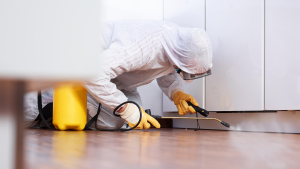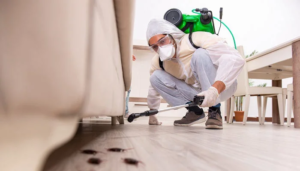Pests destroy crops, damage homes and buildings, and contaminate food supplies. They also transmit serious diseases to humans and livestock.
Preventive control involves removing the food, water and shelter that attract pests. It also includes sanitation, repairing leaks, picking up litter, and using physical barriers. It also includes cultural practices and soil solarization. Contact Seaside Pest Control now!

Pest infestations can cause property damage, health issues and disruption to businesses. Preventive pest control strategies can reduce the need for more drastic and expensive reactive treatments. Effective prevention includes routine inspections, sealing entry points, storing food properly and regularly emptying trash, and smart landscaping practices. It also involves educating building occupants about recognizing early signs of pest problems so they can take action before the problem gets out of hand.
Many pests live in or around buildings, and their numbers can increase or decrease depending on weather conditions. Rain or freezing temperatures may kill pests or suppress them, while warm weather encourages their growth and reproduction. Pest populations can also be impacted by natural predators, parasites and pathogens that kill or reduce their numbers.
Sealing entry points and ensuring that all windows, doors, and screens are in good condition can significantly decrease the number of pests entering homes or commercial properties. Clutter provides places for pests to breed and hide, and it should be eliminated. It’s important to regularly clean floors and surfaces, particularly around kitchens, bathrooms, and garbage areas. Trash should be emptied promptly, and food should be stored in tightly sealed containers. Regularly cleaning and vacuuming carpeting, upholstery and drapes can also help prevent pest infestations.
Properly storing firewood and compost, and keeping piles of wood and other materials away from buildings can also reduce the likelihood of pest infestations. Overhanging branches and bushes should be trimmed, as they can provide pests with pathways into buildings.
Educating building occupants about pests, their habits, and ideal habitats can also help people recognize early warning signs and take prompt action before pests become a problem. This can reduce the need for costly reactive treatments and promotes a sustainable approach to pest control.
Finally, using less toxic baits and traps as first lines of defense can significantly reduce the need for chemical sprays. These are preferable to fumigating or spraying chemicals around the entire structure, and they can be safe for children and pets if they’re used correctly. It’s always a good idea to consult a pest control professional before using these methods.
Suppression
Applied when pest populations reach unacceptable levels, suppression methods focus on eliminating or deterring pests through preventative measures. This may include treatments that directly kill pests or alter their environment, such as insecticides and fungicides. These can be used on their own or as part of an Integrated Pest Management (IPM) program. IPM involves a combination of natural, biological, chemical, cultural, and physical controls that together can prevent the growth of pests or their damage to desirable plants, animals, and people.
Weather and topography can limit the growth of many pest species. The availability of food and shelter also influences pest population size. Many pests cannot survive in areas where their food source is exhausted or they are exposed to predators, parasites, disease organisms, or other factors that disrupt their life cycles.
Plants, insects, nematodes, viruses, and vertebrate animals that interfere with humans or their economic interests can be considered pests. They can negatively affect soil health, nutrient content, and available moisture, displace desired species, and disrupt terrestrial and aquatic ecosystems. Pests can also contaminate food, clothing, and other materials.
Some organisms – natural enemies – can help control pest populations. They eat, parasitize, or injure the pests and thus keep their numbers low. Predators, nematodes, and pathogens are natural enemies of weeds, plants, and insects. Fungi are often used as natural enemies of insects because they can infect the insect’s cuticle.
The use of pesticides in agriculture, forestry, and landscaping to reduce the number or size of unwanted organisms can lead to the selection of resistant organisms. Rotating pesticides and reducing the amount of chemicals applied to a given area can reduce the risk for developing resistance.
Some plants, trees, or animals are more resistant to pests than others. Choosing varieties of plants, wood products, and structures that are naturally more resistant to pests can lower maintenance costs by preventing severe infestations.
Eradication
Pest control is the practice of preventing or eliminating organisms that damage or interfere with human activities, crops, livestock, and ecosystems. Organisms considered pests include insects (e.g., ants, beetles, flies, wasps, rodents and termites), birds, weeds, and other unwanted animals or plants. The goal of pest control is to protect public health by limiting the spread of diseases that pests carry, safeguard agriculture and food supplies, preserve property from damage, and maintain ecological balance by preventing invasive pest species from disrupting ecosystems.
Different types of pests require various management strategies. Continuous pests need regular control methods; sporadic pests are migratory or cyclical and require occasional controls; potential pests are organisms that do not normally pose a threat but may become a problem under specific conditions.
Physical Traps and netting, baits and other trapping techniques, and temperature control are all common physical pest control methods. These methods are typically less expensive than chemical treatments and can be effective in small infestations. However, they may require more maintenance and attention than other methods.
Chemical Control
When other control measures fail, pesticides are usually used to reduce or eradicate the pest. These chemicals include repellents, which deter pests from entering or moving through an area; insecticides, which kill insects; fungicides, which control fungi; and herbicides, which control weeds. These substances may be applied directly to a pest, or they can be placed in an environment where the pests live or hide. Most pesticides are toxic to humans; they should only be used by trained and certified applicators in accordance with the label instructions.
If a pesticide application fails to control a pest, it is important to identify the cause of the failure. Sometimes pests develop resistance to a particular pesticide; other times, the application was not correct for the type or severity of infestation.
Homeowners can help their pest control efforts by removing items that attract pests, such as food and trash, keeping garbage and compost bins securely closed, and sealing gaps around doors and windows. They can also use natural pest control methods, such as the introduction of parasitic wasps or nematodes to target certain types of pests, and by choosing organic fertilizers and mulches to improve soil quality.
Monitoring
When pests invade homes, businesses or food production facilities they can cause serious damage and health hazards. Their feces can contaminate food or make asthma and allergies worse, and the chemicals used to get rid of them can poison people and pets. Everyone plays a role in safe pest control. Building owners, managers and maintenance workers have a responsibility to keep their properties free of pests and to report problems promptly. And residents can help by reporting maintenance and cleaning issues to building owners or management, keeping windows and doors shut when needed and using pest-repelling products wisely.
Monitoring is one of the most important tools of proper Integrated Pest Management (IPM). It helps determine the population size and distribution of a pest, as well as the effectiveness of any control measures taken. Monitoring can be as simple or as complex as a spreadsheet, but it should always include some type of identification, time stamp and location information. Observations can also be recorded with video or photography and compiled into a database.
A common tool for monitoring is a trap, which can be a plastic or cardboard base covered with glue or another sticky substance that prevents pests from leaving once they have crawled into it. Traps may be set in pest-vulnerable areas, which are generally any locations where conditions are favorable for a pest to establish and thrive. Kitchens and food-handling areas are prime PVAs, as are any outdoor areas where food or shelter is available.
The frequency of monitoring varies depending on the severity and urgency of a pest problem. If a brown recluse spider is discovered in a school, for example, intensive monitoring might be required so that an appropriate response can be quickly implemented. Otherwise, it might be possible to ignore the problem until more evidence of a pest becomes apparent.
A key question in pest monitoring is how often traps should be checked. Ideally, traps should be checked at least weekly, but this can be difficult if a pest management program is dependent on a small number of field sites and other factors that affect sampling.
